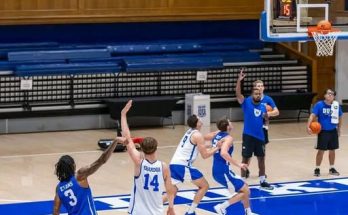On a sun-drenched afternoon in Tuscaloosa, the air pulsed with anticipation. The University of Alabama, a name synonymous with college football dominance, welcomed a new monument into its sacred football pantheon—a statue of the man who redefined excellence, discipline, and leadership for a generation of athletes and fans alike: Nick Saban.
With alumni, current players, fans, and former staff gathered around Bryant-Denny Stadium’s Walk of Champions, the unveiling of the Nick Saban statue wasn’t just the dedication of a sculpture. It was a celebration of an era that transformed a university, reinvigorated a state, and reshaped the very fabric of college football. It was a moment years in the making and richly deserved—an everlasting tribute to a coaching titan.
A Career Worth Immortalizing
Nick Saban’s tenure at Alabama was more than successful—it was transcendent. From 2007 to 2023, Saban turned Alabama football into the gold standard of collegiate athletics. Under his guidance, the Crimson Tide won six national championships and nine SEC titles, posted a remarkable career record of 201–29 at Alabama, and sent dozens of players to the NFL, many of whom became stars at the next level.
But Saban’s influence extended far beyond the win-loss column. He instilled a culture of relentless work ethic, personal discipline, and mental toughness. His “Process” philosophy became legend—quoted in locker rooms, classrooms, and boardrooms. Under Saban, Alabama didn’t just win—they dominated, out-prepared, and outlasted.
The Ceremony: Emotion, Honor, and History
The ceremony, held just outside the gates of Bryant-Denny Stadium, drew an estimated 15,000 fans who came to pay tribute to the greatest coach in Alabama history—and arguably, college football history. Former players such as Tua Tagovailoa, Derrick Henry, Mac Jones, and Mark Ingram made emotional returns, joining Alabama legends and dignitaries like Greg Byrne, the Alabama Athletics Director, and Governor Kay Ivey.
A large crimson-and-white drape veiled the statue, as the crowd roared chants of “Saban! Saban!” Minutes later, after a heartfelt speech by Byrne and a video montage chronicling Saban’s storied career, the drape was lifted to thunderous applause.
The bronze statue captured Saban mid-stride, headset in hand, with his trademark focused scowl—eyes forward, embodying determination and leadership. Designed by renowned sculptor Blake Lee, the piece was described as “art that breathes legacy.”
“It’s more than a statue,” said Lee. “It’s a symbol of consistency, excellence, and a relentless pursuit of greatness.”
Saban Speaks: A Rare Glimpse into the Coach’s Heart
When Coach Saban took the podium, the stadium hushed. Known for his no-nonsense approach, Saban allowed rare emotion to surface.
“I never imagined this,” Saban said, his voice slightly cracking. “I came to Alabama to build a program that everyone could be proud of—players, fans, this great university. But I never thought about a statue. I only thought about the next play.”
He continued: “This isn’t about me. It’s about all the people who believed, who worked, who sacrificed—coaches, staff, players, fans. We did this together. And I hope this statue reminds future generations that success is earned, not given.”
A Statue Among Legends
Saban’s statue now joins the other Alabama coaching greats outside the stadium, including Bear Bryant, Gene Stallings, Wallace Wade, and Frank Thomas. Each statue stands as a pillar in the cathedral of Alabama football history, but Saban’s feels different—not just because of his recent dominance but because of the modern dynasty he built amid unprecedented pressure and scrutiny.
He didn’t inherit a machine—he built it from the ground up after a tumultuous post-Stallings era. When he arrived in 2007, Alabama was reeling. In less than two seasons, Saban had Alabama contending. By 2009, they were champions.
The statue, placed at the entrance near the Walk of Champions, faces the field where Saban orchestrated countless triumphs. Tour guides already anticipate thousands of annual visitors to pause, reflect, and take photos beside the legend himself.
Voices from the Crimson Tide Family
Former players, now NFL stars and mentors themselves, offered moving tributes.
Derrick Henry, 2015 Heisman Trophy winner: “Coach Saban didn’t just shape me into a better football player—he made me a better man. Every principle he taught us applies to life.”
Tua Tagovailoa, 2018 national championship hero: “I wouldn’t be who I am today without Coach. He believed in me, pushed me, challenged me. Seeing this statue brings back so many memories—it’s emotional.”
Julio Jones, one of Saban’s first transformative recruits, added, “This is long overdue. Coach Saban changed the game. Every SEC school had to evolve because of what he built here.”
The Process Lives On
Though retired from coaching, Nick Saban remains deeply involved in the sport as an analyst, mentor, and ambassador for the game. He also continues working with the Nick’s Kids Foundation, which he and his wife, Terry Saban, co-founded to support children, education, and community initiatives across Alabama and beyond.
Terry Saban was also present at the ceremony, standing proudly next to her husband.
“Nick may have called the plays, but we were always in this together,” she said. “This statue honors our journey and the beautiful Alabama family we found here.”
Why This Moment Mattered So Deeply
This moment was about more than football. For many fans, the statue represents hope, pride, and resilience. Saban arrived when Alabama needed a leader—not just on the field but for a fanbase yearning for identity and dominance once again.
He revived traditions, set new standards, and made Alabama football a national powerhouse year after year. During his tenure, Alabama never had a losing season and never stopped chasing greatness.
Saban also represented stability in an era of change—amid playoff expansions, NIL debates, and coaching carousel madness, he remained the bedrock of consistency.
Legacy Secured in Bronze
The idea of a statue may seem grandiose to some. But for Alabama, for college football, and for sports fans across America, this statue is a rightful testament to the greatest coach of the modern era.
As night fell over Tuscaloosa and the statue glistened under the stadium lights, fans stayed. They laid crimson flowers at the base, snapped selfies, and some even teared up.
You don’t always recognize the greatness of an era while living in it. But with Nick Saban, fans knew. They witnessed history every fall Saturday—and now, they’ll be able to point to it for generations.
A Message Etched in Stone
At the base of the statue is an inscription that reads:
“Success is not a result of spontaneous combustion. You must set yourself on fire.” – Nick Saban
A fitting quote for a man who ignited the Alabama dynasty and kept the fire burning for nearly two decades. As the statue of Nick Saban stands tall at Bryant-Denny, it doesn’t just memorialize a man—it reminds us all of the standard he set and the heights he inspired others to reach.
College football has seen its share of legends, but few have etched their name into the sport’s heart like Nick Saban. His statue is more than a piece of metal; it’s a story carved in bronze—one of discipline, dominance, and a dream realized. It reminds the Crimson Tide faithful that with the right leadership, belief, and tireless work, anything is possible.



